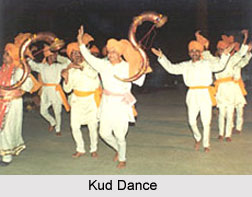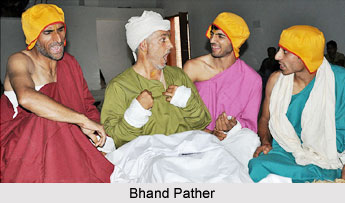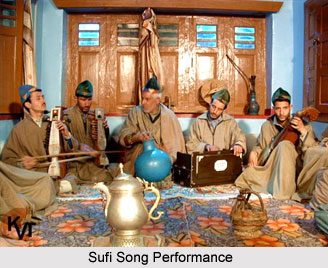Jammu the land of the Dogras, offer an entirely different fare of dances and music. Over the centuries long spell of separation from their soldier, husbands and brothers have led the hardy but graceful women of the Duggar to evolve many diverting dances and songs to keep themselves in cheer in their free moments. The songs of separation the ever-increasing yearning for reunion with the beloved, the hard life on the mountain slopes and various other themes connected with their day-to-day life find their echo in folk songs and dances.
 Kud: It is basically a ritual dance performed in honour of Lok Devatas. This dance style is performed mostly during nights. It is spontaneous dance and people of all ages and sexes participate in this folk dance form. Instruments used during this dance are Narshingha, chhaina, flute, drums etc. It is the rhythm of music which controls the movement of participants. This dance continues for the whole night. Number of participants ranges from 20 to 30 members.
Kud: It is basically a ritual dance performed in honour of Lok Devatas. This dance style is performed mostly during nights. It is spontaneous dance and people of all ages and sexes participate in this folk dance form. Instruments used during this dance are Narshingha, chhaina, flute, drums etc. It is the rhythm of music which controls the movement of participants. This dance continues for the whole night. Number of participants ranges from 20 to 30 members.
Heren: It is a traditional theatre form performed during Lohri festival by 10-15 members. This style is mostly performed in hilly regions of Jammu.
Fumenie and Jagarana: The ladies perform this dance style on the eve of groom`s departure to in-laws house. Both the songs are sung by a group of females consisting 15-20 members. This traditional dance form depicts the feelings and emotions of women folk.
Bakh/Gwatri/Kark/Masade: It is a chorus narrative singing sung by a group of 10 singers without the accompaniment of any musical instruments.
Gwatri: It is a singing/ dance combined tradition in which the singers narrate some text, which is enacted by the Gwatari dancers.
Karak: It is a tale ballet singing form sung by a community called `Jogies`. They narrate a popular folk tale in their dance style, performed by three members with accompaniment of typical folk instrument called `Rabab`.
Benthe: This is chorus singing tradition performed specific community of tribal called Gujjar and Bakerwal. 5-7 members perform dance.
 Bhand Pather: It is a traditional folk theatre style combination of play and dance in a satirical style where social traditions, evils are depicted and performed in various social and cultural functions. Bhand Jashan is performed by a group of 10 to 15 artists in their traditional style accompanied by light music for the entertainment of people.
Bhand Pather: It is a traditional folk theatre style combination of play and dance in a satirical style where social traditions, evils are depicted and performed in various social and cultural functions. Bhand Jashan is performed by a group of 10 to 15 artists in their traditional style accompanied by light music for the entertainment of people.
Chakri: It is most popular form of Kashmiri folk music. It has some resemblance with chakra of mountainous regions of Uttar Pradesh. Normally Garaha, Sarangi, Rabab were the musical instruments used in the past. But now the harmonium too has made its way in its presentation.
Sofiana Music: Sofians musiqui came to Kashmir from Iran in the 15th century. Over the years it has established itself as the classical music form of Kashmir and has incorporated a number of Indian Ragas in its body. Hafiz Nagma in fact, used to be part of sofiana music. The instruments used in this form are Santoor, Sitar, Kashmiri Saz, Wasool or Tabala. In Hafiz Nagma a dancer is a female while her accompanists on various instruments are males. Hafiza moves her feet on musical notes.
 There are only a few families in Kashmir who are practicing this musical form in Kashmir. Whereas the tallest Ustad Ghulam Mohd. Qaleenbaft is unable to move out because of health problems, Ustad Ghulam Mohd. Saznawaz and Ustad Abdul Ghani Namathali are imparting training to their family members and are the practicing artists.
There are only a few families in Kashmir who are practicing this musical form in Kashmir. Whereas the tallest Ustad Ghulam Mohd. Qaleenbaft is unable to move out because of health problems, Ustad Ghulam Mohd. Saznawaz and Ustad Abdul Ghani Namathali are imparting training to their family members and are the practicing artists.
Marriage songs and dance (Wedding dance): In Ladakh marriage is conducted with great enthusiasm and lasts for at least a couple of days. The main feature of Ladakhi marriage is recitation of long narratives. The marriage party led by a leader sings marriage songs. Singers wear unique costumes especially made for the gay ceremonies.
Jabro: This dance form is peculiar to Chang- Thang and Rong areas of Ladakh region. Both males and females face each other forming rows or circles and dance leaping hand in hand forwards and backwards reciting melodious songs.
Alley Yate: It is basically the dance of shepherds of Zanskar area of Ladakh region. It is a combination of poetry and dance. This dance is peculiar to the time when people go out of their homes with flocks.






